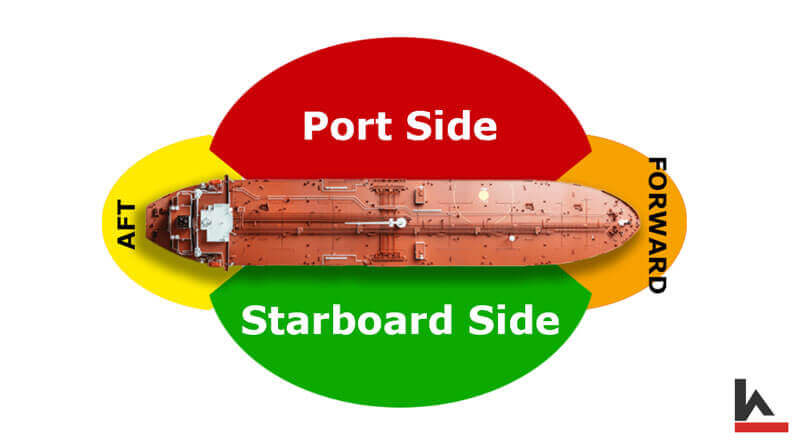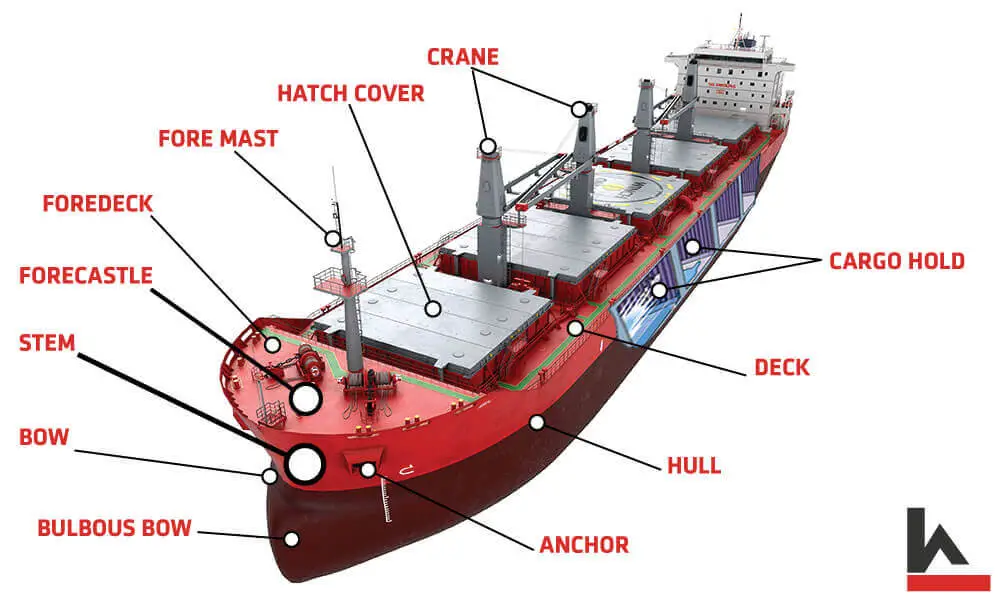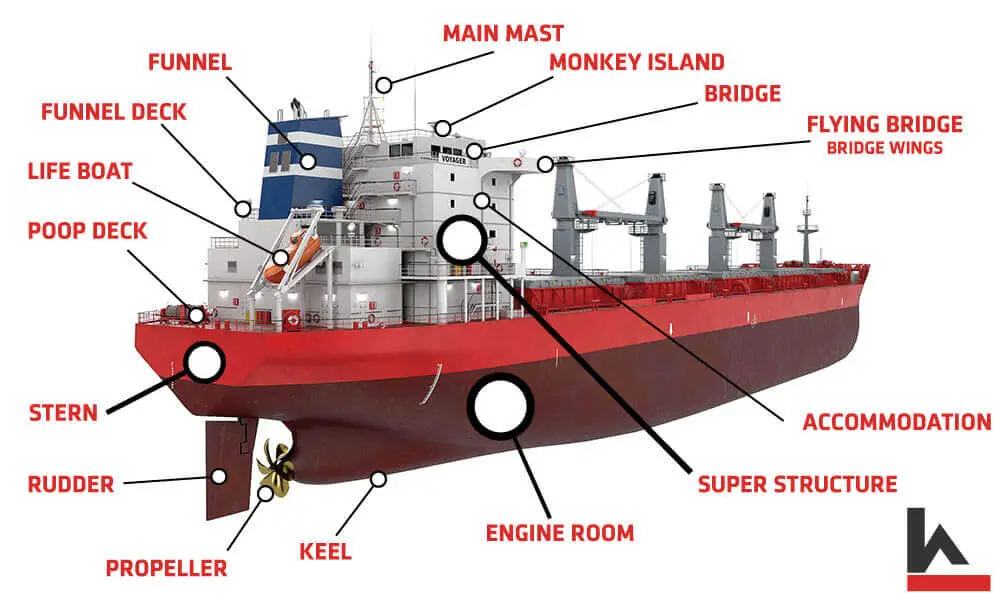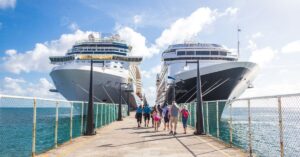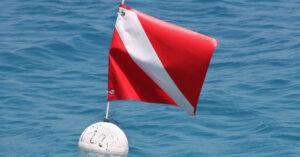Have you ever stood on the shore and gazed out at the majestic ships passing by, wondering about the names of the different parts of ships? If so, you’re not alone. Ships have been fascinating vessels transporting goods and people across the oceans for centuries. Understanding the various parts of a ship will make you appreciate their complexity and the incredibly remarkable engineering that makes them possible.
So, let’s explore the various part of ships, from the engine room to the bridge and everything in between, to discover the impressive world of ships and enrich your maritime knowledge.
Different Parts of a Ship
Some of the basic terminologies used in a ship are the rooms in a ship are called cabins, the kitchen a galley, and the deck indicates the floor (two decks means two floors).
The left side of a ship is referred to as the port side, whereas the right side is known as the starboard side. The ship’s back end is called AFT, and the front end is called the Fore or Bow. The hull is the main structure of a ship.
The ship’s rear, also known as the aft end, houses a rudder, which serves the primary function to steer the ship when needed. Behind the rudders, there will be propellers, and it can be one or more than one. A ship with two propellers is called a twin-screw vessel.
The AFT end has the draft marks painted on it, and the draft mark can indicate how heavily a ship is loaded (a very heavily loaded ship will have most of its draft mark immersed in water). A ship is like a small floating town, so let us briefly discuss the various parts of a ship:
Stem
The stem is the forwardmost part of a ship (or bow of the vessel) and is usually an extension of the ship’s keel. The ship’s keel may have extended up to the gunwale (the top edge of a ship’s hull) to form a curved edge called the stem.
A stem inclined at an angle to the water surface is called a raked stem, and when it is perpendicular to the water surface (straight), it is called the plumb stem.
Bulbous Bow
This bulb-shaped part protrudes at the bow (front) of the ship and is just below the water’s surface. This bulb cuts the water along, reduces the drag, and squeezes the water around the hull to increase the ship’s speed and make the vessel more fuel efficient.
It may also reduce the pitching up slightly by increasing the buoyancy of the forward part of the ship. A large ship with a bulbous bow at the bow is usually 10 to 15% more fuel efficient than a similar-sized ship without a bulbous bow.
Bow Thrusters
Bow thrusters are propellers located at the front of a ship, designed to provide lateral thrust and enhance maneuverability in confined areas. They draw water into tunnels and expel it to generate sideways force.
This allows ships to navigate through ports, canals and during docking procedures with precision. Bow thrusters offer improved safety, efficient operations, and enhanced control.
Forecastle
Forecastle is among the foremost parts on the upper deck of a ship, with a length of greater than 7% of the total deck length.
In a military vessel, it was used by the soldiers for taking defensive positions. A forecastle is used for anchoring and similar things in today’s ships.
Anchor
An anchor is a heavy metal part, and its shape is designed to grip the sea bed firmly. The anchor is fastened to the loose end of a strong chain, and the other end is secured to the ship structure.
The ship typically moves from berth to berth, but due to heavy rush, a ship may have to wait until it is allotted a berth. A ship remains in the shallow water till it gets a berth, and it uses the anchor to secure the ship at a location.
The ship’s crew drops the anchor into the shallow water, and the claw-like structure digs into the sea bed and keeps the ship from drifting away.
Hull
A hull is the watertight body of a ship, and in most vessels, it is covered with the deck. However, in some ships, it may be partially or entirely open. On the top of the deck, you will find a deckhouse and superstructures like a funnel, cranes, etc.
The hull may have been divided into many decks or compartments depending on the type of ship. The hull may have transverse or longitudinal structural members to strengthen it.
Cargo Hold
Cargo holds are enclosed areas in a ship for carrying cargo. The cargo hold is right under the ship’s deck, and it holds different capacities depending on the size of the ship. Cargo ships usually have larger cargo holds and may feature derricks or cranes.
The primary purpose of the cargo hold is to protect the cargo and keep it safe till it is delivered to its destination. The cargo hold may have been divided into several levels or partitions to enable the secure carrying of coal, grain, ores, etc.
Hatch Cover
Hatch covers make the cargo hold water-tight space and protect the food grains or other cargo in the cargo hold during the voyage.
The hatch cover’s design depends on the ship type and size, but today, most ships have hydraulically driven hatch covers since they are quick, effective, and enable faster cargo handling.
Mast
The mast of a ship is a tall spar (a thick and strong pole), usually built vertically on the center line of a ship. A ship can have two masts: the foremast and main mast.
The mast of a ship has multiple purposes, such as carrying sails (in earlier days), derrick (a lifting device), navigation light, radio aerial, scanners, and many others.
Deck
You can define the boat deck as a floor covering the ship’s hull structure. This is the primary working space for the ship.
Ships usually have more than one level inside the hull and a multilevel superstructure above the primary deck (similar to a multi-floor building, but in ships, the floors are termed as decks).
A ship can have different decks at different sections or parts of the ship. Depending on the location of a ship’s deck, the six major types of the deck are main deck, poop deck, upper deck, lower deck, weather deck, and foredeck, and a naval ship may have other decks like helicopter deck, hanger deck, etc.
The primary purpose of the deck is structural, that is, to hold the hull structure and provide the floor as a working space.
Foredeck
The Fore deck is the forward part of a ship, the deck space between the superstructure and the forecastle structure.
Main Deck or Weather Deck
This is the uppermost continuous deck running from bow to stern. It provides a working area for the crew during normal operating conditions.
On larger ships, the main deck often includes various structures such as the bridge, accommodation areas, and sometimes even recreational spaces.
Upper Deck
The upper deck is situated above the main deck and provides additional working and storage space.
It is typically used for machinery, cargo handling, and sometimes even recreational activities, such as open-air spaces for passengers on cruise ships.
Lower Decks
These decks are below the main deck and accommodate various functions, including storage, machinery, crew cabins, and engine rooms.
Lower decks are essential for maintaining the ship’s stability and housing critical systems and equipment.
Poop Deck
A poop deck is the deck constructed in the aft (rear) of the superstructure of a ship. The word ‘poop’ originates from the French word la poupe (meaning stern) or the Latin word Puppis.
Hence the poop deck is technically a stern deck. The poop deck has no connection with the slang word poop.
Promenade Deck
This deck is usually found on passenger ships and provides open space for leisure and relaxation. It is often situated on the uppermost level, offering panoramic views of the surrounding ocean.
Promenade decks may feature amenities such as lounges, restaurants, and outdoor seating areas.
Funnel and Funnel Deck
A ship’s funnel is a chimney whose function is to discharge the engine exhaust and smoke from the boiler safely. There can be more than one chimney.
Additional care is taken when discharging the engine exhaust from the funnel to control atmospheric pollution. The funnel is never straight and inclines the aft to safeguard the deck and the navigation bridge from the chimney gasses.
Stern
The stern is the aft-most or the extreme back part of a ship, and its location is opposite the bow (the foremost part of the ship). The term stern typically includes the entire back of the ship. You can see the propellers and rudders at the stern end.
Monkey Island
The monkey island is the topmost height of the ship that, is accessible to the crew and is located above the bridge. In olden times, the monkey island was used by sailors for planetary and solar studies.
The monkey island is an essential part of a ship, and it accommodates VDR (voyage data recorder) capsule, AIS (automatic identification system) antenna, radar scanners linked to the radar mast, equipment for communication, a weather vane, etc.
Ship Bridge
The bridge of a ship is planned as the heart of the vessel, and it should be able to provide a clear and unhindered view of the surrounding area. You can compare this with the cockpit of an aircraft.
The ship’s bridge houses the major steering equipment and other essential equipment, such as communication systems, navigation charts, engine control systems, and many others. You can call the bridge the commanding position of the ship and control the ship’s complete movement.
When present on the bridge, the ship’s captain has complete command over the bridge, and in their absence, the senior officer on the bridge has the command.
Bridge Deck
Located at the top of the superstructure, the bridge deck houses the ship’s bridge, including the navigation equipment, control room, and captain’s quarters.
From the bridge deck, the captain and officers have a clear view of the surroundings and can safely navigate the ship.
Bridge Wings
A bridge wing is an extended area on the top of the ship’s superstructure. Its primary purpose is to provide an unhindered clear view of the ship’s fore, aft, and sides.
The bridge wing contains controls and communication equipment. And the extent of controls and navigation controls on the bridge depends on the captain’s needs.
Accommodation
The accommodation of a ship is the living house for the crew. The accommodation has all the basic amenities for living, including a galley (kitchen), crew cabins, common rooms, recreation room, gymnasium, saloon, medical room, food courts, dining hall, laundry, etc.
It also has a garbage disposal unit, refrigeration, an air-conditioning system, a freshwater processing system, etc.
Engine Room
The engine room is the place that houses the machinery required for the propulsion of the ship. And the machinery can be diesel engines, diesel generators, etc.
Typically, a ship’s engine room is located at the bottom, towards the back (or aft) of the vessel. This strategic positioning aims to optimize storage space. It also ensures closeness to the ship’s propeller, significantly contributing to the vessel’s safety in case of a disaster, as the vessel can continue to function as long as the engines can generate power.
Keel
A keel is one of the main parts of a ship. It runs longitudinally along the bottom centerline of the ship (from the bow to stern). And it is the bottommost structural member of the ship, and the ship’s hull is built around the keel.
Due to its location and function (holding and supporting the hull structure), the keel is often referred to as the ship’s backbone, as all the major components of the ship are connected to it.
Duct keel
A duct keel is a welded box-type structure at the ship’s center and is provided in double-hull ships. The duct keel offers the space for water pipelines, ballast pipelines, and piping systems.
Rudder
Rudders are flat hollow structures and are placed aft of the propeller. The rudder is used to steer and direct the ship.
The parts of a rudder (depending of its type) are the rudder trunk, movable flap, hinge, main rudder blade, drain plug, rudder bearing, and links. There are four types of rudders, balanced rudder, semi-balanced rudder, unbalanced rudder, and flap rudder. The rudder is controlled using a steering gear system.
Propeller
A propeller is a mechanical device that has blades fitted on its shaft. A ship’s propeller is rotated by a diesel engine (through a gear system) or by an electric motor with a gear system. The diesel generator supplies the motor’s electric power.
The rotating propeller generates the thrust required for the propulsion of the ship. The propeller forces the sea water backward and helps the ship move forward. The thrust is caused due to the favorable angle on the blades.
The propeller is made from corrosion-resistant metals like Nickle Aluminum bronze alloys, manganese bronze, or even stainless steel. It can be up to 4 propellers that propel the ship forward.
Side Thrusters
These are similar to a propeller (may be smaller) and fitted on the side of the ship’s bow or stern. Side thrusters help maneuver the ship at a low speed in crowded waters (near the port) or a narrow canal.
Side thrusters are also known as tunnel thrusters. The side thrusters impact the operating cost of a ship. They are usually powered by hydraulic or electric power. A bow thruster (mentioned above) is considered a side thruster.
Freeboard
The freeboard of a sailing ship is the distance between the water line and the upper deck level. And the measurement is taken at the lowest point of sheer where the entry of water into the ship may be possible.
The purpose of freeboard between various sections of a ship is to keep it stable and prevent it from sinking. Keeping the freeboard of a ship low or high depends on the type and purpose of the ship.
The calculation of the freeboard for a vessel may have to be approved by the relevant regulatory authority before the ship is commissioned.
Emergency Generator Room
The emergency generator room is on the main deck. And it houses an emergency diesel generator with a switchboard and other accessories.
This generator is operated when the main supply goes off for any reason. And it helps restore the main generators by providing the necessary power.
Ballast Tanks and Bunker Tanks
Ballast tanks are compartments for carrying seawater and help stabilize the vessel. The amount of water in the ballast tank can be increased or reduced as necessary.
Ballast tanks need extra coating protection since seawater is highly corrosive and can damage the surfaces of the ballast tank. Bunker tanks of a ship are compartments used for the storage of fuel.
Frequently Asked Questions
What are the basic terminologies used in a ship?
Some of the basic terminologies used in a ship are:
- The rooms in a ship are called cabins.
- The kitchen is called a galley.
- The deck indicates the floor (two decks mean two floors).
- The left side of a ship is referred to as the port side. While the right side is known as the starboard side.
- The ship’s back end is called AFT, and the front end is called the Fore or Bow.
- The hull is the main structure of a ship.
What are the terms used for the front and back parts of a ship?
The front part of a ship is called the Fore or Bow. While the back part of the ship is known as the AFT or Stern.
What is the difference between the port side and starboard side?
The left side of a ship is referred to as the port side. Whereas the right side is known as the starboard side.
What do the draft marks on a ship indicate?
The draft marks painted on the AFT end indicate how heavily a ship is loaded. A very heavily loaded vessel will have most of its draft mark immersed in water.
What are rudders and propellers, and what roles do they play in a ship’s operation?
A rudder is a steering device located at the ship’s rear (aft end), used to control the ship’s direction. Propellers, located behind the rudders, are the rotating parts that create forward or backward thrust to move the vessel through the water. A ship with two propellers is called a twin-screw vessel.
Conclusion
A ship is a complex and intricately designed vessel composed of interconnected parts. These parts contribute to the functioning, navigation, and overall efficiency of a ship. And ensure the safety and well-being of its crew and cargo.
From the hull to the propulsion system, from the bridge to the cargo holds, each component has a specific purpose that ultimately allows the ship to navigate treacherous waters and transport goods across vast distances.
Understanding the different parts of ships not only gives us insight into the fascinating world of maritime engineering but also highlights the essential role that ships play in global trade and commerce.


